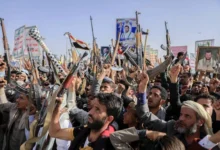A win against Iranian arms smuggling to Yemen

SMA NEWS – WASHINGTON
by Ryan Brobst & Bradley Bowman
The U.S. Navy announced on Tuesday that it has seized 70 tons of a missile fuel component and 100 tons of an explosive precursor. The items were being smuggled on a ship traveling from Iran to Yemen. This incident demonstrates that Iran continues to quite literally fuel the conflict in Yemen and the associated humanitarian crisis there. It underscores the need to ensure the U.S. and partner forces in the region have the capability necessary to interdict Iranian weapons smuggling.
How did the seizure occur?
The Coast Guard Cutter John Scheuerman and guided-missile destroyer USS The Sullivans intercepted a fishing vessel as it transited international waters in the Gulf of Oman. Tehran has used this route to smuggle weapons and other materiel to the Houthis systematically. The vessel carried 70 tons of ammonium perchlorate, which can be manufactured into a composite fuel when combined with other materials and used to power ballistic missiles. It also carried 100 tons of urea, which can be used as a precursor when manufacturing explosives. “This was a massive amount of explosive material, enough to fuel more than a dozen medium-range ballistic missiles depending on the size,” said Vice Adm. Brad Cooper, commander of U.S. Naval Forces Central Command and U.S. 5th Fleet. Iran’s illicit transfer of weapons and related materials to Yemen is “irresponsible, dangerous, and leads to violence and instability across the Middle East,” Cooper said.
Iranian support for the Houthis is not new. Tehran has armed the Houthis since at least 2009 and increased aid in 2015 after the Houthis overthrew the internationally recognized Yemeni government. That development prompted an intervention from Saudi Arabia and the United Arab Emirates. The warring parties reached a ceasefire earlier this year but failed to extend it in October. There have been continuing violations since then, spurring growing concerns that the ceasefire is slowly falling apart. The Houthis have little incentive to establish a durable peace deal if they can rely on a continued supply of weapons and support from Iran. Despite this fact, international ire has focused largely on Saudi Arabia, often ignoring the Iranian weapons that are helping fuel the conflict and humanitarian crisis.
While the Houthis have used artillery and small arms and employed child soldiers, their preferred tactic for striking Saudi Arabia and the United Arab Emirates has been with drones, cruise missiles, and ballistic missiles. Since the war began, the Houthis have reportedly fired at least 550 drones and 350 ballistic missiles at Saudi Arabia and launched at least 375 cross-border attacks in 2021 alone. And in January 2022, the Houthis fired two ballistic missiles at Al-Dhafra Air Base, which houses American service members. The intercepted fuel could have powered ballistic missiles capable of replicating such an attack.
Iran supplies the Houthis by smuggling weapons on dhows, although it also smuggles some supplies over land. This willingness to use a variety of routes mirrors Iran’s approach in arming Hezbollah in Lebanon. Tehran has sent weapons to Hezbollah over the Iraq-Syria land bridge and transports some by sea. Tehran’s use of maritime routes for smuggling helped inspire the establishment of multiple combined task forces in the region. Combined Task Force 150 focuses on the Gulf of Oman and Northern Arabian Sea, Combined Task Force 151 counters piracy throughout the Middle East, Combined Task Force 152 patrols inside the Persian Gulf, and the recently established Combined Task Force 153 operates from the Suez Canal, through the Red Sea, to the waters off the Yemen-Oman border. The U.S. and its partners have also conducted several exercises in the region, including training focusing on capabilities highlighted in this seizure.
A durable solution to the crisis in Yemen and the associated humanitarian crisis depends significantly on staunching the flow of Iranian weapons. While the news this week represents a welcome win, more must be done. Washington must work with its regional partners to increase intelligence sharing related to Iranian smuggling and build increased multilateral interdiction capability and capacity. Considering the national security threats emanating from Yemen and the humanitarian suffering there, resourcing these interdiction efforts is money well spent.







